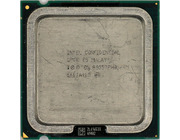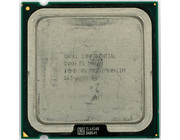A weird model number! Basically it's identical to a Core 2 Duo E6400. It runs at the same clock-frequency, same L2-cache size and same FSB.
Looking at Intels' ARK I see that they've categorized the E6405 as server-CPU instead of desktop. > Read more
An early engineering sample of the Core 2 Duo 'Conroe'. The first batches are called 'A0-silicon' or 'A0-stepping'. This particular CPU is A1-stepping and dates back to the last week of 2005; about a half year before it's official launch in July 27, 2006.
Back in 2005 Intel still had their Pentium 4 and Pentium D as flagship processors. The Pentium D was able to keep up with the Athlon64 X2 but the Athlon was often favourable. Many people speculated about the new 'Conroe' processor and as more information became known, people got exciting about it's performance.
It took a while before benchmarks popped up. Just a few engineering samples were floating around and when one popped up on auction sites it was being sold for a decent price. Besides the low quantity of leaked engineering samples the then new 'Conroe' processor needed a specific motherboard equipped with VRM11. Normal Pentium 4 and Pentium D have the same socket but are equipped with VRM10.1 and often BIOS-support and/or chipset support was absent. Back in '06 I wrote How-to: Compatibility of socket 775 for Intel systems for those who wondered if they can run a Core 2 Duo on their motherboard.
Just a few months before it's official release some benchmarks and screenshots popped up showing that the first samples could outperform high-end AthlonX2's and Pentium D's with ease. At it's release many people opted for the Core 2 Duo and those first CPU's already ran beyond 3GHz. In 2006 I had this E6400 running at 3.2 GHz using air-cooling. It ran happy for years until it was replaced by a faster system. > Read more
The E6750 was released in July 2007, one year after the initial release of the first generation Core 2 Duo. Along with the E6750 came the E6540, E6550 and E6850. These CPU's featured a faster FSB and a newer stepping (G0) which has lower idle power consumption.
My engineering sample dates back to early March 2007, roughly 4 months before the release. > Read more
A popular model of Core 2 Duo when launched. Offered decent performance and enthusiasts were able to overclock these CPU's fairly easy. > Read more
Not all Xeon's use S771 (sockets usually seen on workstation/server motherboards). This Xeon can be fitted in S775 sockets which are used in normal desktop systems. Internally it's equivelant to a Core 2 Duo E6400 which has the same core and the same 2133MHz clock frequency and cache sizes. > Read more
By launching the Core 2 Duo CPU's, Intel shook the processing world awake. AMD had, compared to the Pentium 4 and Pentium D, superior products with the Athlon64 and Athlon64 X2. With the Core 2 Duo Intel didn't have hot-running sluggish CPU's anymore. Instead they sort of reclaimed the 'best-CPU'-throne.
Before the launch of the Core 2 Duo, at July 27 2006, some samples already hit the market. These samples indicated that the Core 2 Duo was fast and a good overclocker. Consider having an E6400 (2,13GHz) running at 3,2GHz in the third-quarter of 2006! More than enough CPU's of that time are able to do this without problems.
The Core-microarchitecture has new key features that improves performance. Parts of it are based on the Pentium-M (that could do more per MHz than the Pentium 4 and was a lot cooler) but then reorganized. Using shared L2-cache (Advanced Smart Cache) there aren't huge delay's in cache access and techniques like Advanced Digital Media Boost can process 128-bit SSE2 instructions in one cycle rather than two (Pentium 4/D needed two cycles for this). Intel's Core 2 Duo has more new interesting features which I'm not going to mention here ![]() . The result of all the new techniques is that the Core 2 Duo can do a lot more per MHz than the old Pentium 4 while being energy-efficient and those two things are very important. > Read more
. The result of all the new techniques is that the Core 2 Duo can do a lot more per MHz than the old Pentium 4 while being energy-efficient and those two things are very important. > Read more

















